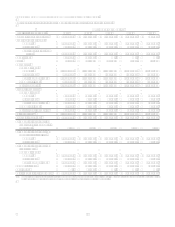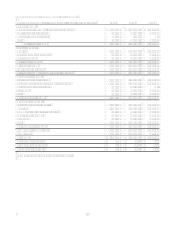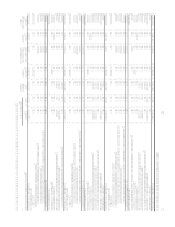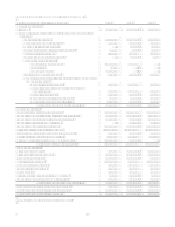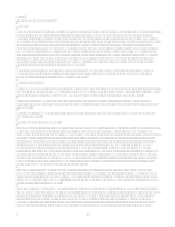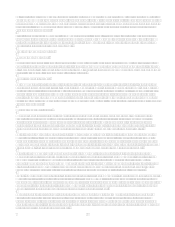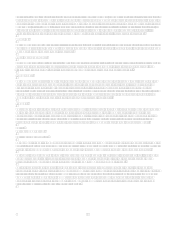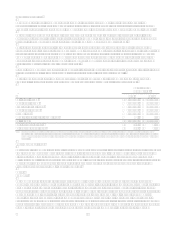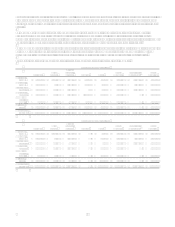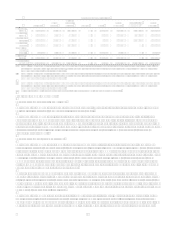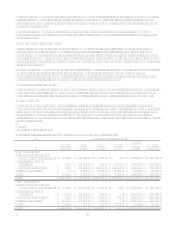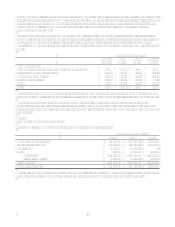Capital One 2006 Annual Report Download - page 91
Download and view the complete annual report
Please find page 91 of the 2006 Capital One annual report below. You can navigate through the pages in the report by either clicking on the pages listed below, or by using the keyword search tool below to find specific information within the annual report. 73
As of December 31, 2006 and 2005, the balance in Mortgage loans held for sale was $10.4 billion and $0.2 billion,
respectively.
Loan Securitizations
Loan securitization involves the transfer of a pool of loan receivables to a trust or other special purpose entity. The trust sells
an undivided interest in the pool of loan receivables to third-party investors through the issuance of asset backed securities
and distributes the proceeds to the Company as consideration for the loans transferred. The Company removes loan
receivables from the Consolidated Balance Sheets for securitizations that qualify as sales in accordance with SFAS No. 140,
Accounting for Transfers and Servicing of Financial Assets and Extinguishment of Liabilitiesa Replacement of SFAS
No. 125 (SFAS 140). The trusts are qualified special purpose entities as defined by SFAS 140 and are not subsidiaries of
the Company and are not included in the Companys consolidated financial statements. Gains on securitization transactions,
fair value adjustments related to residual interests and earnings on the Companys securitizations are included in servicing
and securitizations income in the Consolidated Statements of Income and amounts due from the trusts are included in
accounts receivable from securitizations on the Consolidated Balance Sheets.
The gain on sale recorded from off-balance sheet securitizations is based on the estimated fair value of the assets sold and
retained and liabilities incurred, and is recorded at the time of sale, net of transaction costs, in servicing and securitizations
income on the Consolidated Statements of Income. The related receivable is the interest-only strip, which is based on the
present value of the estimated future cash flows from excess finance charges and past-due fees over the sum of the return paid
to security holders, estimated contractual servicing fees and credit losses. To the extent assumptions used by management do
not prevail, fair value estimates of the interest-only strip could differ significantly, resulting in either higher or lower future
servicing and securitization income, as applicable.
As of December 31, 2006 and 2005, the retained interest on the Consolidated Balance sheet was $2.2 billion and $2.4 billion,
respectively. See Note 22 for additional detail.
Allowance for Loan and Lease Losses
The allowance for loan and lease losses is maintained at the amount estimated to be sufficient to absorb probable principal
losses, net of principal recoveries (including recovery of collateral), inherent in the existing reported loan portfolios. The
provision for loan losses is the periodic cost of maintaining an adequate allowance. The amount of allowance necessary is
based on distinct allowance methodologies depending on the type of loans which include specifically identified criticized
loans, migration analysis, forward loss curves and historical loss trends. In evaluating the sufficiency of the allowance for
loan and lease losses, management takes into consideration the following factors: recent trends in delinquencies and charge-
offs including bankrupt, deceased and recovered amounts; forecasting uncertainties and size of credit risks; the degree of risk
inherent in the composition of the loan portfolio; economic conditions; legal and regulatory guidance; credit evaluations and
underwriting policies; seasonality; and the value of collateral supporting the loans. To the extent credit experience is not
indicative of future performance or other assumptions used by management do not prevail, loss experience could differ
significantly, resulting in either higher or lower future provision for loan and lease losses, as applicable. The evaluation
process for determining the adequacy of the allowance for loan losses and the periodic provisioning for estimated losses is
undertaken on a quarterly basis, but may increase in frequency should conditions arise that would require the Companys
prompt attention. Conditions giving rise to such action are business combinations or other acquisitions or dispositions of
large quantities of loans, dispositions of non-performing and marginally performing loans by bulk sale or any development
which may indicate an adverse trend.
As of December 31, 2006 and 2005, the balance in the Allowance for loan and lease losses was $2.18 billion and $1.79
billion, respectively. See Note 5 for additional detail.
Premises and Equipment
Premises and equipment are stated at cost less accumulated depreciation and amortization. The Company capitalizes direct
costs (including external costs for purchased software, contractors, consultants and internal staff costs) for internally
developed software projects that have been identified as being in the application development stage. Depreciation and
amortization expenses are computed generally by the straight-line method over the estimated useful lives of the assets. Useful
lives for premises and equipment are as follows: buildings and improvements5-39 years; furniture and equipment3-10
years; computers and software3 years. See Note 8 for additional detail.



